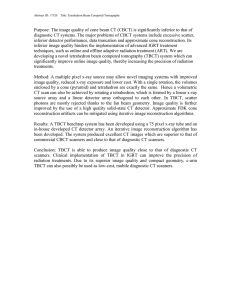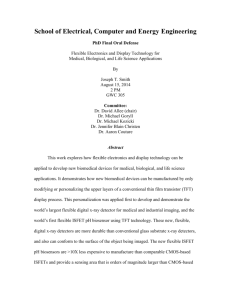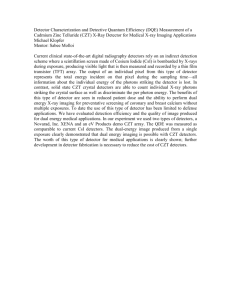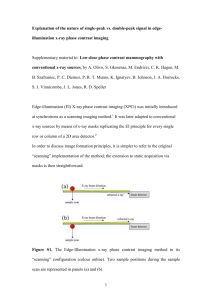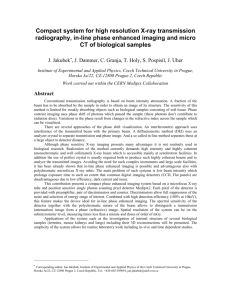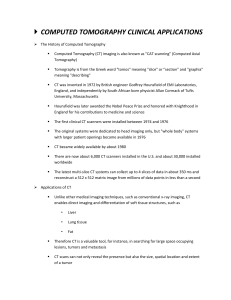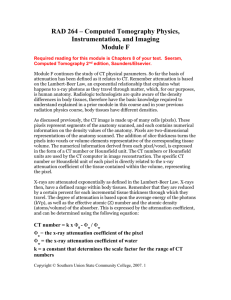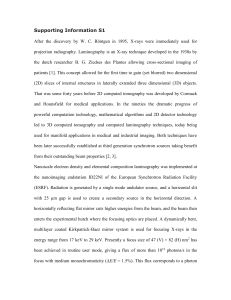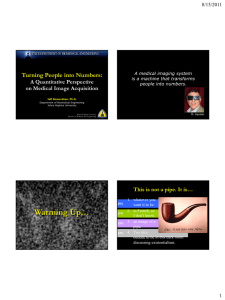CT Physics, Instrumentation and Imaging
advertisement
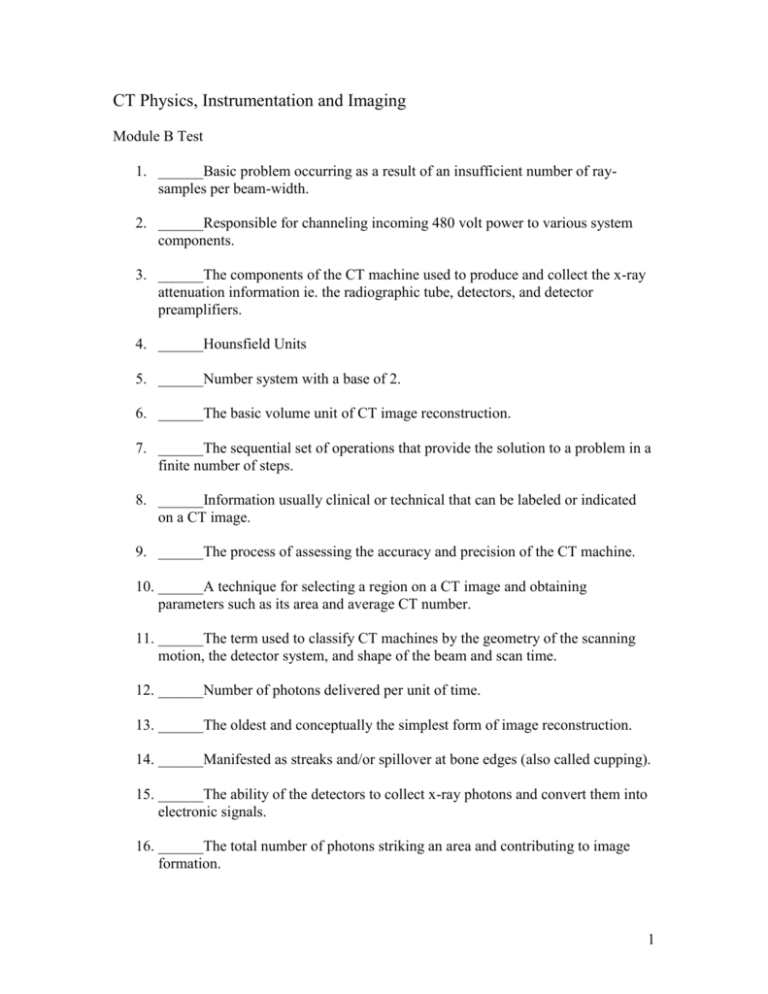
CT Physics, Instrumentation and Imaging Module B Test 1. ______Basic problem occurring as a result of an insufficient number of raysamples per beam-width. 2. ______Responsible for channeling incoming 480 volt power to various system components. 3. ______The components of the CT machine used to produce and collect the x-ray attenuation information ie. the radiographic tube, detectors, and detector preamplifiers. 4. ______Hounsfield Units 5. ______Number system with a base of 2. 6. ______The basic volume unit of CT image reconstruction. 7. ______The sequential set of operations that provide the solution to a problem in a finite number of steps. 8. ______Information usually clinical or technical that can be labeled or indicated on a CT image. 9. ______The process of assessing the accuracy and precision of the CT machine. 10. ______A technique for selecting a region on a CT image and obtaining parameters such as its area and average CT number. 11. ______The term used to classify CT machines by the geometry of the scanning motion, the detector system, and shape of the beam and scan time. 12. ______Number of photons delivered per unit of time. 13. ______The oldest and conceptually the simplest form of image reconstruction. 14. ______Manifested as streaks and/or spillover at bone edges (also called cupping). 15. ______The ability of the detectors to collect x-ray photons and convert them into electronic signals. 16. ______The total number of photons striking an area and contributing to image formation. 1 17. ______Ability of the CT system to discriminate between tissues with similar densities. 18. ______The movement of the CT table relative to the gantry by a given increment in order to position a patient for the next scans (slice or volume). 19. ______A crystal detector that converts x-ray energy into light energy. 20. ______The association of an address in memory with an alphanumeric mnemonic. 21. ______The capability of an imaging system to record a distinct image of two or more closely spaced high contrast objects. 22. ______The decrease in the intensity of a transmitted x-ray beam due to the combined effects arising from the photoelectric effect and Compton scattering of the primary x-ray beam as it travels through an object. 23. ______When a voxel is occupied by two different tissues, its CT numbers will be an average of the CT numbers of the two tissues, weighted by their relative partial volumes within the volume elements (Voxels). 24. ______Measurement data before it is sent to the array processor for reconstruction into image data. 25. ______The diagnostic radiologic principle that strives to keep radiation doses at a level necessary to accomplish optimal imaging without excessive radiation dosages. 26. ______A technique that emphasizes or enhances sharp discontinuities such as interfaces, borders, and edges. a. algorithm b. ALARA c. aliasing d. annotation e. attenuation f. back-projection g. beam hardening artifact h. binary coded decimal i. calibration j. CT numbers k. data acquisition system l. detector efficiency m. edge enhancement n. fluence o. flux p. generation q. incrementation r. low contrast detect-ability s. partial volume effect t. PDU u. scan data (raw data) v. scintillation crystal w. spatial resolution x. symbolic address y. voxel z. region of interest 2 CT Physics, Instrumentation and Imaging Module B Test Key 1. C______Basic problem occurring as a result of an insufficient number of raysamples per beam-width. 2. T______Responsible for channeling incoming 480 volt power to various system components. 3. K______The components of the CT machine used to produce and collect the xray attenuation information ie. the radiographic tube, detectors, and detector preamplifiers. 4. J______Hounsfield Units 5. H______Number system with a base of 2. 6. Y______The basic volume unit of CT image reconstruction. 7. A______The sequential set of operations that provide the solution to a problem in a finite number of steps. 8. D______Information usually clinical or technical that can be labeled or indicated on a CT image. 9. I______The process of assessing the accuracy and precision of the CT machine. 10. Z______A technique for selecting a region on a CT image and obtaining parameters such as its area and average CT number. 11. P______The term used to classify CT machines by the geometry of the scanning motion, the detector system, and shape of the beam and scan time. 12. O______Number of photons delivered per unit of time. 13. F______The oldest and conceptually the simplest form of image reconstruction. 14. G______Manifested as streaks and/or spillover at bone edges (also called cupping). 15. L______The ability of the detectors to collect x-ray photons and convert them into electronic signals. 3 16. N______The total number of photons striking an area and contributing to image formation. 17. R______Ability of the CT system to discriminate between tissues with similar densities. 18. Q______The movement of the CT table relative to the gantry by a given increment in order to position a patient for the next scans (slice or volume). 19. V______A crystal detector that converts x-ray energy into light energy. 20. X______The association of an address in memory with an alphanumeric mnemonic. 21. W______The capability of an imaging system to record a distinct image of two or more closely spaced high contrast objects. 22. E______The decrease in the intensity of a transmitted x-ray beam due to the combined effects arising from the photoelectric effect and Compton scattering of the primary x-ray beam as it travels through an object. 23. S______When a voxel is occupied by two different tissues, its CT numbers will be an average of the CT numbers of the two tissues, weighted by their relative partial volumes within the volume elements (Voxels). 24. U______Measurement data before it is sent to the array processor for reconstruction into image data. 25. B______The diagnostic radiologic principle that strives to keep radiation doses at a level necessary to accomplish optimal imaging without excessive radiation dosages. 26. M______A technique that emphasizes or enhances sharp discontinuities such as interfaces, borders, and edges. 4 This workforce solution was funded by a grant awarded under the President’s Community-Based Job Training Grants as implemented by the U.S. Department of Labor’s Employment and Training Administration. The solution was created by the grantee and does not necessarily reflect the official position of the U.S. Department of Labor. The Department of Labor makes no guarantees, warranties, or assurances of any kind, express or implied, with respect to such information, including any information on linked sites and including, but not limited to, accuracy of the information or its completeness, timeliness, usefulness, adequacy, continued availability, or ownership. This solution is copyrighted by the institution that created it. Internal use by an organization and/or personal use by an individual for noncommercial purposes is permissible. All other uses require the prior authorization of the copyright owner. 5
